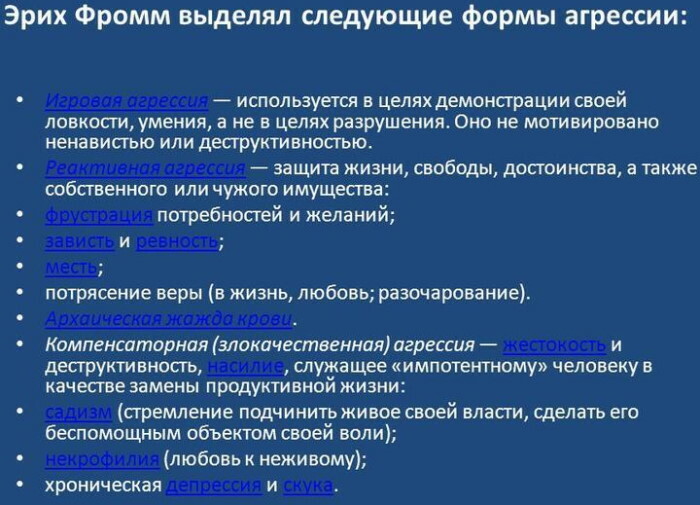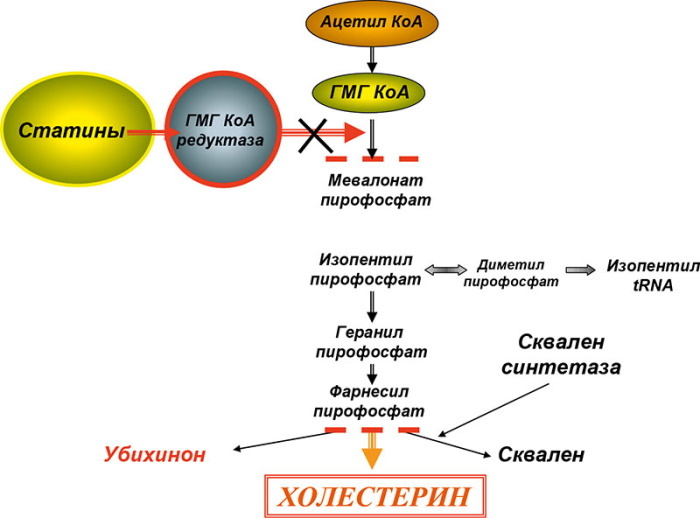Content
- Definition of aggressiveness and aggression: similarities and differences
- Psychological theories and schools
- The concept of E. Fromm
- F. Perls
- The theory of E. Burns
- The theory of A.A. Reana
- The theory of M.V. Alfimov and Trubnikov V.I.
- Types of aggressiveness
- By Eric Fromm
- Benign aggressiveness
- Malignant aggressiveness
- Modern classification
- Forms of manifestation
- Reasons for the appearance
- How to identify and prevent development
- How to get rid of aggressiveness
- Video about aggression
Aggressiveness (hostility) Is in psychology the subjective predisposition of the subject to behavior, the purpose of which is causing harm to others or a similar affective state accompanied by the appearance of anger or anger. According to psychologists, despite the fact that aggressiveness accompanies human society at all stages of its development, for the individual it is not characteristic, and children learn it, adopting the model of behavior from their parents.
For the first time, the concept of aggressiveness appeared in the psychoanalysis of Z. Freud, who explained this quality of behavior as an unconscious human desire for death and destruction. Subsequently, the concept of "aggressiveness" was refined by E. Fromm and E. Bern and a group of Russian psychologists who defined aggressiveness as the force with which a person expresses love or hate towards others or himself.
Definition of aggressiveness and aggression: similarities and differences
Aggressiveness in psychology is a personality trait expressed in a preference for the use of violent methods to achieve their goals. This term is directly related to the concept of "aggression" and comes from the Latin "aggredi" (to attack).
Until the beginning of the nineteenth century. “aggressive” was understood as any active behavior, both benevolent and hostile. Subsequently, the term acquired a narrow focus, implying an active or passive behavior of an individual aimed at causing physical or mental harm to others or to oneself, as well as to an animal or inanimate object, through it destruction.
American pediatric neuropsychiatrist and developer of gelstat therapy Laurette Bender understood aggression as increased activity and desire for self-affirmation. Spanish scholar Jose Rodriguez Delgado described aggression as an act of hostility, surprise attack and destruction, accompanied by actions aimed at causing harm to society or an individual personality. At the same time, the concept of "aggressiveness" is a behavioral reaction that obeys a destructive force.
American psychologist Robber Wilson defined aggression as a physical action or threat of such, aimed at reducing the freedom of another individual.
For Eric Fromm, aggressiveness is inflicting physical or mental harm not only on a person, but also on an animal, as well as any inanimate object.
Arnold Bass interprets the concept as a tendency to any behavior that threatens or harms other people.
E.V. Zimanovskaya calls aggressiveness any behavior aimed at subjugating the will of an outsider. In the works of A.A. Rean, one can find the opinion that aggression implies the infliction of harm by a person on any living or inanimate object.
The Russian psychologist also gives the concept of "aggressiveness" as a readiness for hostile actions towards an outsider a person, prepared by the individual's readiness to perceive or interpret the behavior of others in an appropriate way.
In modern psychology, the concepts of "aggression" and "aggressiveness" are often confused. So E.P. Ilyin understood aggressiveness as the ability of a person to react hostilely (aggressively) when a conflict situation arises. At the same time, the psychologist understood aggressive action as a situational reaction and a manifestation of aggressiveness. With the regular repetition of aggressive actions, we can talk about the emergence of aggressive behavior.
Psychological theories and schools
Aggressiveness in psychology is, according to Z. Freud, the natural state, which is considered an indicator of the animal nature in a human being and is explained by the unconscious human attraction to death and destruction.
The "Psychoanalytic Theory of Aggressiveness" created by the author of psychoanalysis connects the phenomenon with the development of libido and defines it as an integral part of the pregenetal organization. According to Freud, at the phallic phase of development, the child's aggressiveness is directed against his parents, brothers or sisters, and the destructive actions themselves are the nature of the unconscious and feed on the energy of Thanatos ("death drive") and in the absence of a suitable object can lead to self-destruction personality.
The concept of E. Fromm
Erich Fromm divided aggressiveness into benign and malignant:
- Benign aggression is understood as a biologically adaptive response that occurs when a threat to life appears. This behavior is characteristic of all people and animals without exception and manifests itself as a response to the elimination of a real threat or its cause. Such aggressiveness, according to the scientist, is not destructive and arises as a response to genuine destructive aggressiveness ("Touch me and I will kill you").
- Malignant (hostile) aggressiveness is a non-adaptive form of aggressiveness, inherent, according to Fromm, exclusively to humans and based not on biological, but on social roots. Examples of malignant aggressiveness are various forms of cruelty and violence (including sexual), sadism and necrophilia.
According to Fromm's theory, a person is cultured only to the extent that he is able to control his elemental, destructive beginning. When these mechanisms are weakened, a tendency towards "malignant" aggression is manifested, accompanied by cruel actions and destructive behavior.
F. Perls
In 1945, the concept of aggressiveness was given by F. Perls in his book "Ego, Hunger and Aggression", where, drawing a parallel between mental and physiological processes, the author determines that digestion requires natural aggression, which allows bite food. According to the author, aggressiveness is accompanied by the process of cognition, for which it is necessary first to break the object, and then to form its mental model.
The task of the psychologist, according to Perls, is to help a person realize his aggressiveness and take responsibility for its manifestation, because by avoiding it, a person brings fear into his life.
The theory of E. Burns
Psyche in Action by Eric Berne defines aggressiveness as a force that helps a person express feelings of love or hate for themselves and their environment. According to the psychologist, an individual can deceive himself or others, weakly showing his feelings or, on the contrary, expressing barely warm feelings with aggression.
Speaking about this method of love or hate, one should also take into account the directions of their expression, since if for some people it is usual express their feelings towards others, then it is common for other individuals to turn aggressiveness mainly on themselves myself.
Thus, a person can hate someone, and the apogee of such aggressiveness will be murder. In another case, the individual may hate himself, which prompts him over time to commit suicide. Both of these actions, according to Berne, are a consequence of aggressiveness, differing from each other only in the direction of action.
The theory of A.A. Reana
The concept of A.A. Reana defines aggressiveness, in the form of an individual's readiness for hostile actions in relation to another individual, provided with a desire to perceive and interpret the actions of others, corresponding way.
In accordance with this concept, "aggressiveness" as a personality trait is associated with hostility, resentment, ill will. Focusing on this, A.A. Rean considers potentially aggressive perception in the form of a stable personality peculiarity of the world perception and world outlook
The theory of M.V. Alfimov and Trubnikov V.I.
Russian psychologists M.V. Alfimova and Trubnikov V.I. mean by "aggression" negative emotions, motives and even negative attitudes. These factors, according to scientists, can play an important role, but are not prerequisites for aggressiveness.
Scientists noted that both emotional arousal and coldness can be inherent in aggressive behavior. The presence of hatred is not necessary here, since the manifestation of aggression can be directed by a person even at the one to whom he has a positive attitude.
Types of aggressiveness
Aggressiveness in psychology is, according to E.P. Ilyin, a personality trait that reflects a tendency to react aggressively when a frustrating and conflict situation arises.
In modern psychology, several options for the classification of aggressiveness are given:
By Eric Fromm
In the concept of the German sociologist "Anatomy of Human Destructiveness", two types of aggressiveness are presented:
Benign aggressiveness
Benign aggressiveness is genetically inherent in a person and manifests itself when a feeling of threat arises. According to Fromm, this type of aggressiveness rarely leads to the destruction of the enemy and has as its purpose only to scare the offender.
Benign aggressiveness can be presented in the form of pseudo-aggressiveness, that is, in an action that can cause harm, but not accompanied by willful intent:
| Unintentional aggressiveness | Associated with accidental harm. A typical example of such aggression is checking a revolver and accidentally firing when the trigger is involuntarily pulled. |
| Play aggressiveness | It is used in educational trainings on skill, dexterity and responsiveness. Doesn't have any destructive goals. |
| Aggressiveness for self-affirmation | It is more characteristic of men and adolescents and has the goal of rendering destructive actions in an attempt to assert self-affirmation in society. |
| Defensive aggressiveness | It is considered a form of manifestation of human biological adaptation. |
Malignant aggressiveness
Malignant aggressiveness manifests itself in the form of cruelty and destructive behavior, is absent in animals and is characteristic only of humans. The main manifestations of such aggressiveness are cruel torture and murder, and such actions are justified only by a person's personal pleasure.
This aggressiveness manifests itself in 3 forms:
| Spontaneous manifestations of aggressiveness | Associated with the destructive potential that grows in constantly operating conditions. When traumatic circumstances appear, this potential is mobilized, accompanied by a sharp outbreak. |
| The destructiveness of vengeance | Aggressiveness out of revenge arises as an individual's response to injustice that has harmed him or someone close to him. It can often be accompanied by extreme cruelty. |
| Ecstatic destructiveness | It is associated with the aggressiveness directed by a person to harm himself (drug addiction, substance abuse, suicide) and can be triggered by a feeling of loneliness, helplessness or melancholy. |
Modern classification
In modern psychology, the classification of aggressiveness is also adopted, dividing it into:
| Physical | Which is characterized by the use of physical force in relation to people around or inanimate objects. |
| Verbal | Here the individual realizes negative feelings through words (shouts, quarrels) or verbal reactions (threats, curses). |
| Direct | This form of aggression is directed directly at a specific individual. |
| Indirect | Requires the implementation of aggression through roundabout ways (gossip, stinging jokes) or undirected and disordered actions (hitting pillows, smashing dishes, shouting). |
| External | Aggression directed at others. |
| Internal | The destructive actions of the individual are directed at themselves, manifesting themselves in the form of self-humiliation, self-inflicted bodily harm, suicide. |
| Protective | Hostility that becomes a response to someone's provoking (or seemingly such) acts. |
| Provoking | Offensive actions initiated by the "first" individual. |
| Healthy and unreasonable | The boundaries of these destructive acts are blurred, since aggressive manifestation can also be understood as energy. Having a basis, arousing sympathy and a desire to imitate aggressiveness is considered, in psychology, a healthy |
| Hostile | The source of such aggression is considered to be anger, and its purpose is to cause harm. |
| Instrumental | It differs from the hostile one in that harm is not a goal, but only its achievement. |
Forms of manifestation
Aggressiveness in psychology is, according to E. Berna, the power that allows a person to express feelings of love or hate towards himself or his environment.

According to the Bass-Darki questionnaire, an individual is able to show his aggressiveness:
| Direct or physical aggression | Consists in the use of physical force by an individual towards an outsider. |
| Indirect aggression | Hostility indirectly directed at another person (with the help of cruel jokes, ridicule), or is uncontrollable (smashing dishes, throwing things). |
| Irritation | Destructive actions here are associated with emotional arousal (hot temper, rudeness). |
| Negativism | Confrontation can be manifested both by passive resistance and by developing an active struggle aimed at overcoming the foundations traditional for society. |
| Resentment | It manifests itself as hatred or envy of others. |
| Suspicion | It arises as distrust or caution towards other people or their potentially "dangerous" beliefs. |
| Verbal aggression | Allows you to express your negative feelings through a shout or verbal response in the form of a threat or curse. |
| Feelings of guilt | It is expressed in the conviction of a person in his indirect guilt, illegal actions and may be accompanied by the appearance of remorse. |
Reasons for the appearance
Aggressiveness in psychology is, according to D. Burns, the readiness of the individual for destructive behavior, which is not genetic, but acquired during social interaction.
As a personality trait, aggressiveness develops gradually, under the influence of many factors provoking it. Family attitudes, communication with peers and the media stimulate the formation of hostile (aggressive behavior). Observing, children learn how to be aggressive, try to apply their knowledge in practice, and when positive experience, the acquired hostility is consolidated, becoming the dominant feature character.
For adolescents, the formation of aggressiveness is inherent in puberty. The most prone to hostile behavior are young men and women who suffer from feelings of anger and distrust of others, high anxiety, and egocentrism.
In the absence of serious interests or hobbies, narrow-mindedness and lack of financial resources to satisfy needs, there is a tendency to the emergence of deviant behavior, leading to the destruction of the desired things inherent in visible offenders.
In persons over the age of 18, the formation of aggressiveness is facilitated by:
- alcohol and drug addiction;
- traumas of a mental or physical nature acquired in childhood;
- overwork and lack of adequate sleep and rest;
- having personal and financial problems;
- gambling addiction or frequent viewing of horror movies;
- excessively strict upbringing;
- depression, dementia, psychopathy and schizophrenia.
How to identify and prevent development
Aggressiveness is a fairly common behavioral phenomenon that often occurs in psychological practice. His diagnosis is carried out by a psychotherapist, psychiatrist or clinical psychologist based on an analysis of the actions of patients and the frequency of attacks of destructive behavior that arise in him.
To clarify the diagnosis, the following can also be carried out:
- a survey, during which the specialist will try to establish the reasons that caused the appearance of aggressiveness;
- doctor's observation of the patient's actions, a tendency to hostile expression of their actions;
- psychodiagnostic testing, which allows to qualify aggressiveness and to establish in what form it manifests itself.
It is not typical for aggression to arise from scratch, but for its timely prevention, it is necessary to learn to recognize a person's tendency to aggressive behavior.

American psychologist John Burns notes that it is possible to determine the incipient hostility of a person at the moment dialogue, when the interlocutor stops responding to the arguments of the opponent, focusing exclusively on his point vision. According to the expert, this is the beginning of the incipient aggression, which can further provoke destructive (destructive) behavior.
When such a condition appears, Burns in his "Continuum of Aggression" advises to immediately stop conversation or to draw the attention of the interlocutor to the ineffectiveness of communication by asking him to change the format dialogue.
The specialist advises parents who are faced with the aggressive behavior of a child to try to listen to him without getting into conflict and, if possible, to understand his position. For the full growth of the child and the exclusion of further aggressiveness, it is important that he grows up in a calm atmosphere and, if possible, is not a participant in conflict situations between parents.
Psychologists have noticed that young children tend to subconsciously absorb the atmosphere of relationships between parents, and then transfer the usual model of behavior to their family.
Prevention of the child's aggressiveness will be provided by:
- positive hobbies and hobbies (sports, music, scientific pursuits);
- calm, non-conflict atmosphere in the family;
- attention to his needs and feelings, as well as the absence of possible reproaches and criticism of his views and hobbies.
To cope with the manifestation of human aggression, according to psychologists, is possible only through calm, non-aggressive behavior, with a complete absence of provocation to hostile actions.
In the absence of timely assistance, the likelihood of a fatal outcome is high, provoked by the actions of an aggressive person.
To prevent dangerous consequences, people who have encountered aggressiveness should:
- reduce the number of persons present during the conflict;
- let the aggressor express his dissatisfaction ("let off steam");
- try to distract a person with physical work;
- demonstrate a benevolent attitude by suggesting to jointly search for a way out of the current situation;
- if possible, defuse the situation with funny jokes or comments on an abstract topic.
How to get rid of aggressiveness
Treatment of aggressiveness is carried out through psychotherapy, including:
- individual work with a psychologist, allowing you to understand and eliminate the causes of hostility and irritability;
- group trainings, during which conflict situations are simulated, allowing the patient to form his own algorithm of adequate behavior.
In severe cases of aggressiveness, the use of medications, including the use of antipsychotics and benzodiazepines, can complement the work with a psychotherapist.
Aggressiveness in psychology is a stable personality trait, which is characterized by the manifestation of aggression and the perception of any action of others as dangerous or hostile.
Reflected in the theories of Z. Freud, E. Fromm and Russian psychologists, the phenomenon is characteristic of irritable, touchy, often experiencing irritation and anger of people and manifests itself in deviant (destructive) behavior aimed at causing harm to people around, animals or inanimate objects, or at their own destruction the individual.
Video about aggression
Where does aggression come from:



